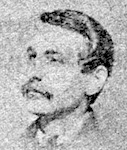 Open main menu
Open main menu
 Open main menu
Open main menu

B.N. Miner
(c. 1835 - ?)
Home State: New York
Branch of Service: Infantry
Before Antietam
Age 26, in the lumber business in Clinton County, NY, he enrolled at Champlain, NY on 22 May 1861 and mustered as 2nd Lieutenant, Company D, 34th New York Infantry on 15 June. He was detailed to the Signal Corps in August 1861. He was on Sugarloaf Mountain in October and November, then with General Banks in the Shenandoah Valley into 1862. He was with General Banks at Culpeper, VA and served as an aide to the General in action there on 9 August 1862.
On the Campaign
On 3 September 1862 he was sent to Sugarloaf Mountain, about 4 miles east of the Potomac River and just over 10 miles south of Frederick, MD:
The range of vision from this point is unequaled by that from any other in Maryland. It includes several prominent fords of the Potomac, the approaches to them in Virginia, and much of the country into which an army passing those fords would move. Lieutenant Miner occupied the summit of Sugar Loaf Mountain on the 3d of September. The position was exposed to an attack, but was courageously held by the officer, who thence reported the advance of the enemy and the direction taken by their trains in the vicinity of Leesburg, their approach to the river, their crossing the Potomac near the Monocacy, and the commencement of their movement into Maryland. He was last seen to send a message announcing the near approach of the enemy, and to then furl his flags as if to leave the station.
There is unofficial information that he left the summit of the mountain, [and the next day] encountered and captured when near its base a courier with dispatches, and, while examining the prisoner, was, together with his flagman [Pvt. A.H. Cook], taken by the enemy's cavalry. It seems probable that the first official information of the enemy's approach to and passage of the Potomac was received at Washington from this officer.
The rest of the War
He was held at Libby Prison in Richmond, VA to 5 October 1862, then at Camp Parole, Annapolis, MD. He returned to duty by May 1863 but mustered out with his Company on 30 June 1863.
After the War
He was a teller at the First National Bank of Syracuse, but his health failed him, and his wife and infant sons died, and by 1870 he was living with his parents and sister Harriet in Poultney, VT and was a life insurance agent. He died there on 17 January 1871 of consumption (tuberculosis), probably contracted at Libby Prison.
References & notes
His basic service from the State of New York,1 as Brinkerhoof N. Miner, with details from Brown,2 source also of his picture. Maryland Campaign details here quoted from Major Myer's Report. Personal details from family genealogists, the US Census of 1870, and a memorial letter to the Syracuse Daily Journal of 21 January 1871. His gravesite is on Findagrave.
He married Ella Pomeroy Bates (1844-1869) in November 1864 and they had twin sons in 1865, but both boys died as infants.
Birth
c. 1835; Syracuse, NY
Death
01/17/1871; Poultney, VT; burial in Oakwood Cemetery, Syracuse, NY
1 State of New York, Adjutant-General, Annual Report of the Adjutant General of the State of New York [year]: Registers of the [units], 43 Volumes, Albany: James B. Lyon, State Printer, 1893-1905, For the Year 1900, Ser. No. 22, pg. 235 [AotW citation 28722]
2 Brown, J. Willard, The Signal Corps, U.S.A. in the War of the Rebellion, Boston: U.S. Veteran Signal Corps Association, 1896, before pg. 233; pp. 227, 231, 236, 241-242, 834 [AotW citation 28723]